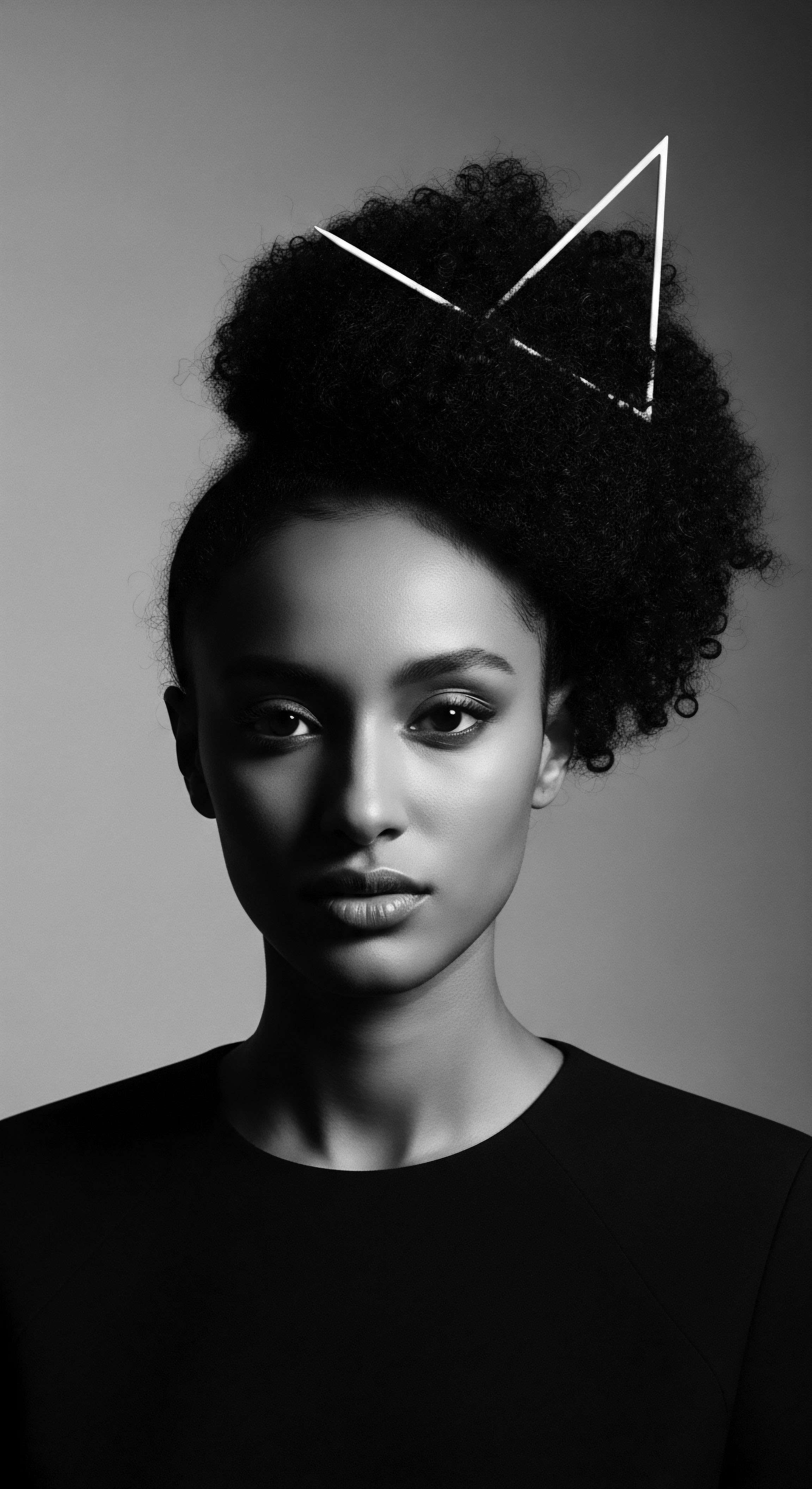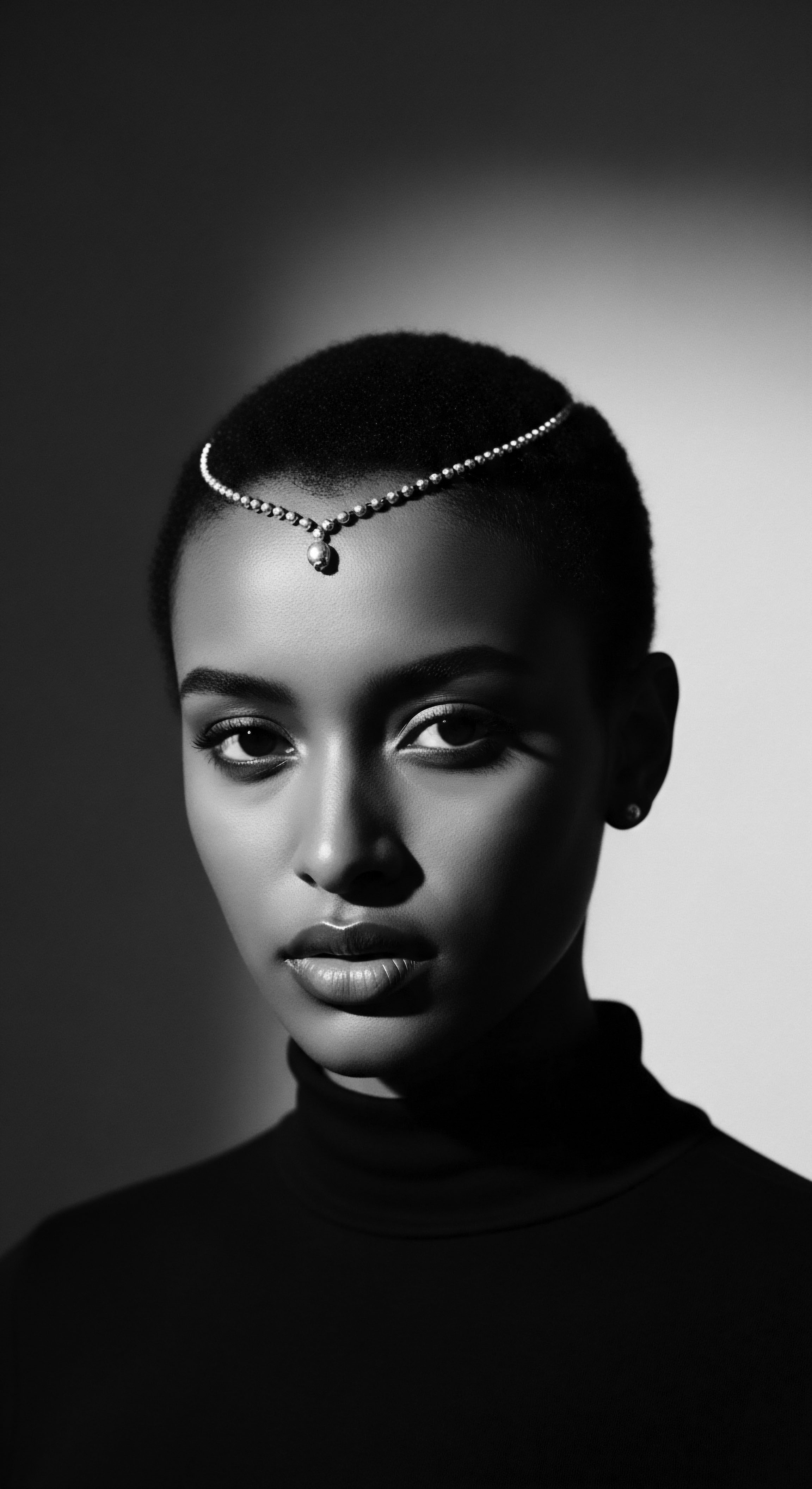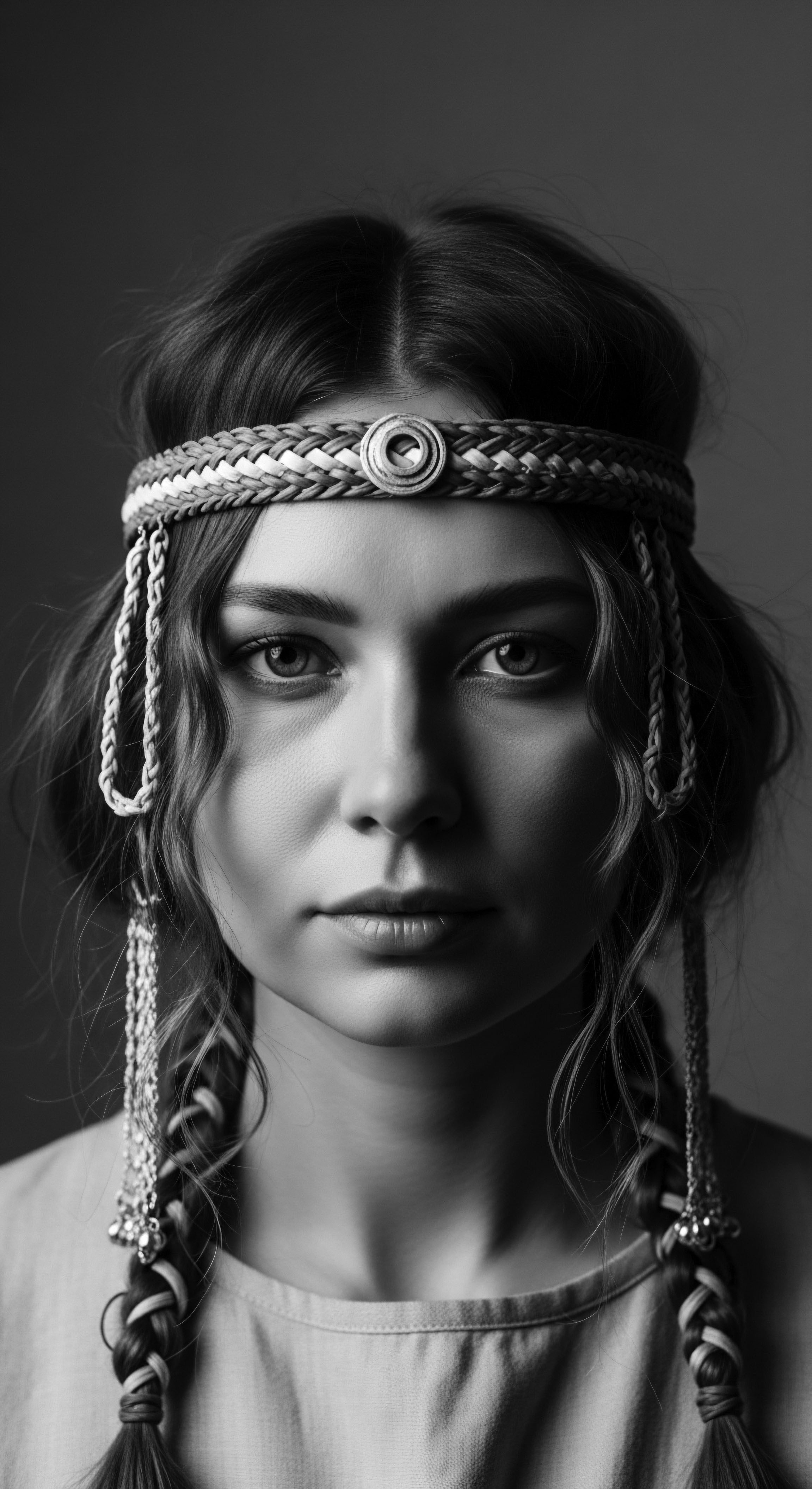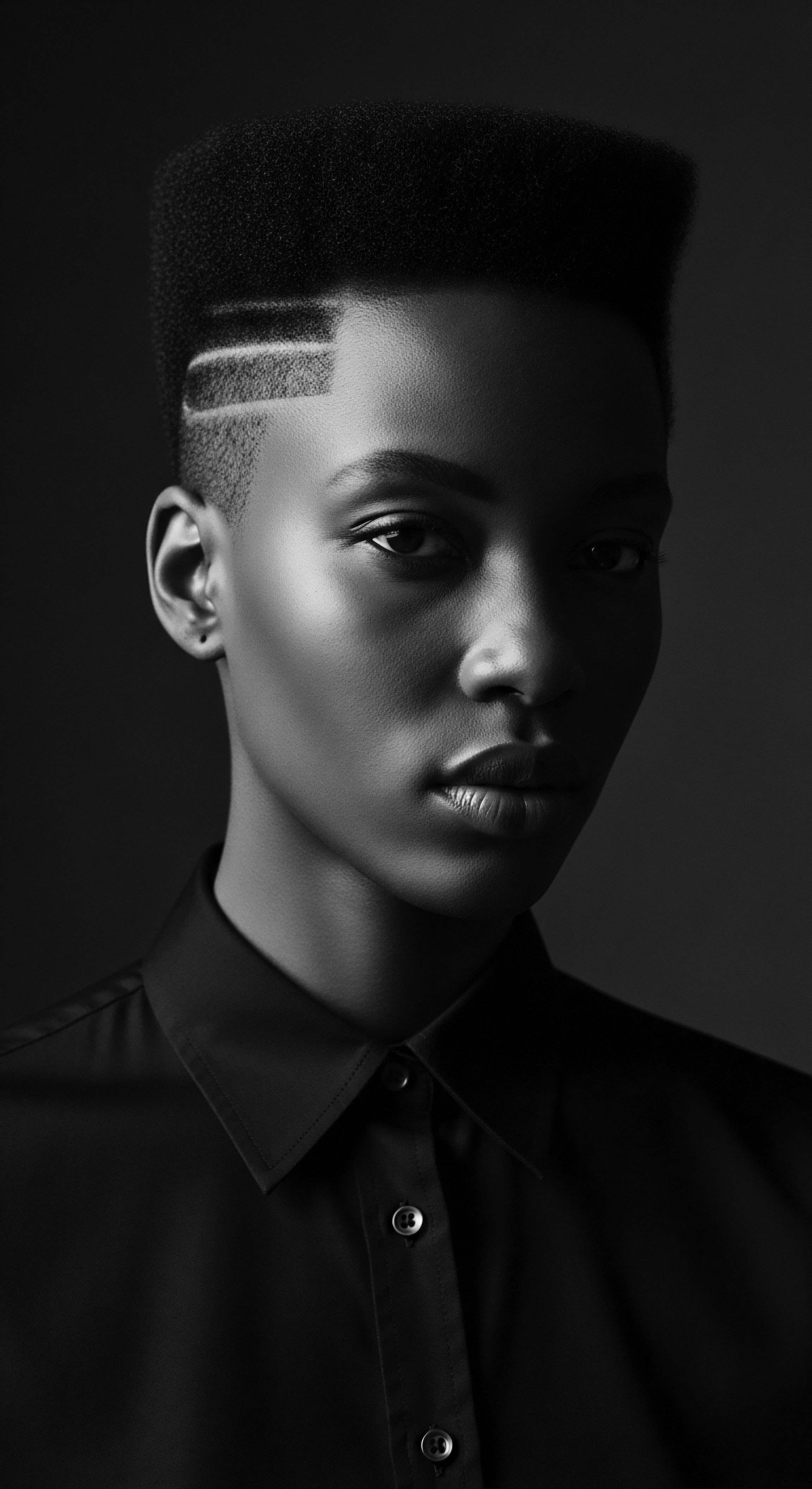
Roots
In the quiet spaces where personal heritage unfolds, we find the answers to how textured hair protection has been preserved across generations. Consider the strands themselves, each coil a testament to a long lineage, a biological marvel shaped over millennia. This understanding begins not with products on a shelf, but with the very structure of the hair and the elemental care practices that echo from the earliest human communities. Hair, particularly textured hair, holds within its very architecture the story of its vulnerability and its resilience.
Its unique helical shape, with its varying curl patterns, means more points of contact between strands, which can lead to friction and dryness if not treated with mindful attention. This inherent characteristic called for particular forms of care, born from observation and deep connection to the natural world. Our ancestors, living in climates where the sun beat down and dust swirled, understood the wisdom of protection not as a trend, but as a biological imperative for the health of their hair and scalp.
Ancestral hair practices offer a fundamental understanding of textured hair, marrying its elemental biology with time-honored methods of protection.

Hair Anatomy and Its Ancestral Implications
The scalp, too, plays a pivotal part in this ancient dialogue of care. It is the soil from which our crown grows, a living ecosystem demanding nourishment and gentle tending. Ancestral communities knew this instinctively. Their practices, whether through the application of natural oils or the creation of protective styles, aimed to maintain a balanced scalp environment, free from excessive dryness or irritation.
The delicate nature of textured hair, predisposed to losing moisture more quickly due to its structural design, meant that moisturizing was not merely an aesthetic choice but a cornerstone of its protection. This biological predisposition laid the groundwork for many of the deeply moisturizing rituals that survive to this day.
From the earliest human settlements, the very act of hair care was intertwined with survival and well-being. Imagine communities, long before the advent of modern science, experimenting with their environment. They discovered that certain plant extracts, animal fats, or natural clays offered shielding from the elements. These initial discoveries formed the basis of what we now recognize as protective practices.
The choice of materials was never random; it was a consequence of keen observation and a deep connection to the land and its resources. This inherent understanding of hair’s needs, passed down through oral traditions and hands-on teaching, became an inherited wisdom, a silent codex guiding future generations.

Ancient Protective Preparations
Early protective preparations involved simple, yet highly effective, natural elements. These were not complex formulas, but rather direct applications from the earth. The use of natural oils and butters, often derived from indigenous plants, served as a primary line of defense. These emollients helped seal in moisture, reduce friction between hair strands, and provide a barrier against harsh environmental conditions.
The precise application of these substances, often accompanied by gentle massage, also stimulated the scalp, promoting circulation and overall scalp health. This rudimentary, yet profoundly effective, approach stands as a testament to the ancestral insight into hair’s fundamental requirements.

How Did Early Societies Shield Hair From the Elements?
Societies across Africa, from ancient Egypt to diverse West African communities, developed distinctive methods to shield hair from the sun, dust, and arid winds. In ancient Egypt, for example, elaborate wigs and headdresses were worn not only as symbols of status but also to protect the scalp and natural hair from the intense heat. These intricate constructions, often adorned with beads or gold, served a dual purpose ❉ aesthetic expression and practical safeguarding. Similarly, the Himba people in Namibia traditionally coat their hair in a red ochre paste called Otjize, a mixture of butterfat and ochre.
This paste offers protection from the sun and insects, while also symbolizing a profound connection to the land and ancestors. These practices demonstrate a sophisticated understanding of localized environmental challenges and the adaptive genius of early protective measures.
The careful selection and preparation of natural materials were paramount. The oils used were often extracted through laborious, hands-on processes, a testament to the value placed on these hair-nurturing substances. These natural elixirs included:
- Shea Butter ❉ Derived from the nuts of the shea tree, abundant in West and East Africa, this butter has been used for centuries for its deep moisturizing and protective qualities, shielding hair from breakage and dryness.
- Argan Oil ❉ From Morocco, argan oil is rich in antioxidants and vitamin E, providing defense against environmental damage and promoting elasticity.
- Mongongo Oil ❉ Sourced from the nuts of Mongongo trees in Southern Africa, this oil forms a protective layer over hair fibers, maintaining shine and health.
These ingredients were integrated into daily life, becoming an inseparable part of personal grooming and communal care. The meticulous application of these natural resources provided a foundational layer of protection, which formed the bedrock for more intricate styling practices.

Ritual
The journey of textured hair protection moves beyond elemental applications into the rich tapestry of ritual. Here, protection becomes a communal act, a shared experience that reinforces identity, communication, and social bonds. These customs, far from being mere vanity, represented sophisticated systems of care, deeply rooted in ancestral wisdom and the rhythmic patterns of daily life.
The communal act of styling hair, often involving family members or skilled practitioners, served as a conduit for stories, histories, and cultural teachings. It was a time of shared laughter, quiet reflection, and the powerful transmission of heritage from elder to youth.
The ritual of hair care, a blend of ancient techniques and communal engagement, transformed protective practices into living traditions that strengthened identity and community.

The Art of Protective Styling
The creation of protective hairstyles stands as a remarkable demonstration of ancestral ingenuity. These styles were designed with both aesthetic appeal and practical preservation in mind. By gathering, twisting, or braiding the hair close to the scalp, these styles minimized manipulation, reduced exposure to harsh elements, and decreased breakage, allowing hair to retain length and remain healthy. This careful manipulation was not about altering the natural texture, but about safeguarding its integrity.
Styles like cornrows, Bantu knots, and various forms of braids, seen across the African continent for thousands of years, embodied this protective philosophy. They were not static forms but dynamic expressions, adapting to the needs and circumstances of each community.

What Social Meanings Did Ancestral Hairstyles Convey?
In pre-colonial African societies, hair carried profound social and cultural meaning. Hairstyles served as a complex language, communicating an individual’s identity, age, marital status, social rank, wealth, and even tribal affiliation. For example, the Yoruba people of Nigeria crafted elaborate styles that symbolized their community roles, while the Himba tribe used specific braiding patterns to signify life stages.
This intricate system of communication through hair was so vital that variations in styles could signify a person’s geographic origins or even their surname. The art of hair styling was, in essence, a living archive of a person’s place within their world, a public declaration written in coils and braids.
This deep connection between hair and identity meant that the act of styling was often a significant event. Girls learned intricate braiding techniques from mothers and grandmothers, a transmission of skill that also imparted cultural values and histories. These sessions were not simply about aesthetics; they were lessons in patience, community, and the heritage that linked them to their forebears. The time spent in communal grooming sessions strengthened social bonds, serving as moments for sharing stories, wisdom, and fostering a sense of collective belonging.
This practice, prevalent in ancient African communities, persists today, maintaining its role as a vital connection point across generations. The communal aspect of hair care reinforced the understanding that an individual’s hair was part of a larger, shared heritage, a crown of collective pride.
Beyond individual expression, protective styles often served as a form of cultural resistance. During the transatlantic slave trade, when enslaved Africans were forcibly stripped of their cultural practices, hair became a silent, yet powerful, means of defiance. Cornrows, in particular, were used to encode messages or even maps to escape routes, becoming a symbol of survival and cultural continuity.
Enslaved women would sometimes braid rice seeds into their hair, a quiet act of preserving sustenance and cultural memory for future generations. This historical context underscores the profound significance of protective styling beyond mere beauty; it was a tool of preservation, resistance, and the tenacious assertion of identity against dehumanization.
| Era or Community Pre-colonial African Societies |
| Typical Protective Techniques Braids, twists, locs, thread-wrapping, natural oils, butterfat, clays |
| Purpose and Heritage Connection Protection from elements, identity markers, communication of status, spiritual connection, communal bonding. |
| Era or Community Transatlantic Slave Trade Era |
| Typical Protective Techniques Simplified braids, cornrows (often with hidden seeds or maps) |
| Purpose and Heritage Connection Survival, resistance, preservation of identity, covert communication. |
| Era or Community Post-Colonial & Diaspora |
| Typical Protective Techniques Braids (box, Fulani), twists, locs, wigs, wraps, bonnets, natural hair movements |
| Purpose and Heritage Connection Reclamation of identity, self-expression, cultural pride, continued hair health. |
| Era or Community These practices showcase an enduring legacy of ingenuity and resilience in safeguarding textured hair through shifting historical landscapes. |

Relay
The enduring wisdom of ancestral practices in textured hair protection carries forward, relayed through generations, adapting and asserting itself in the modern era. This continuation is not a passive inheritance, but an active, living current, blending ancient techniques with contemporary understanding. The fundamental principles observed by our forebears—moisture retention, minimal manipulation, and scalp health—remain cornerstones of effective textured hair care today.
What is it that allows these practices to persist across vast stretches of time and shifting cultural landscapes? It is their inherent efficacy, validated by both lived experience and, increasingly, by scientific inquiry.
The relay of ancestral hair protection practices represents an enduring testament to ingenuity, validated by contemporary understanding and a commitment to cultural continuity.

Scientific Validation of Ancestral Protective Strategies
Modern hair science, with its tools and detailed analyses, frequently corroborates the efficacy of age-old protective methods. For instance, the practice of braiding or twisting hair, long utilized for its protective qualities, directly addresses a key vulnerability of textured hair ❉ its susceptibility to breakage due to friction and environmental exposure. By gathering strands into a unified structure, these styles reduce daily manipulation, decrease tangling, and shield the hair shaft from physical damage, allowing it to grow longer and stronger. This scientific understanding echoes the practical outcomes observed for millennia.
Similarly, the consistent use of natural oils and butters, a practice spanning diverse African cultures, provides a lipid barrier that slows moisture loss from the hair cuticle, a phenomenon well-understood in dermatological and cosmetic science. The ancestors intuited these protective mechanisms through empirical observation, their wisdom proving resilient and relevant.

How Do Traditional Ingredients Compare to Modern Formulations?
The traditional ingredients favored by ancestral communities for textured hair care, such as shea butter, argan oil, and various clays, demonstrate remarkable parallels to the active components sought in modern formulations. Shea butter, for example, known as “women’s gold” in some regions, stands as a prime illustration. Its rich concentration of vitamins A and E, alongside fatty acids like linoleic and oleic acids, promotes scalp health and offers deep hydration, preventing dryness and aiding in moisture retention. Research into its properties confirms its ability to form a protective barrier, thereby reducing moisture loss, a benefit highly valued in contemporary hair care products.
Similarly, indigenous clays, like Rhassoul clay from Morocco, were used to cleanse the scalp and hair without stripping away natural oils, a concept now mirrored in sulfate-free cleansing products designed to preserve hair’s natural moisture balance. These comparisons underscore a continuous lineage of care, where modern science offers a deeper explanation for long-standing practices.
Consider the Chebe powder from Chad, derived from the seeds of the Chebe plant. For generations, women of the Bassara/Baggara Arab tribe have used this powder, mixed with water and moisturizers like shea butter, to retain hair length and enhance thickness. While perhaps not directly stimulating new hair growth, the practice of applying this paste and then braiding the hair effectively coats the strands, reduces breakage, and seals the cuticle, thereby preserving length over time.
This traditional method highlights a key ancestral approach ❉ minimizing hair manipulation and maximizing retention, allowing for the appearance of robust, healthy length without relying on rapid new growth. The effectiveness of this practice lies in its ability to shield the hair from external stressors and internal friction, principles that resonate with modern protective styling advice.
A striking example of ancestral ingenuity in hair protection and its enduring legacy is found in the cultural significance of Cornrows during the Transatlantic Slave Trade. As enslaved Africans were forcibly transported to the Americas, their hair was often shaved as a cruel act of dehumanization and cultural erasure. Yet, even in such dire circumstances, the practice of braiding persisted as a profound act of resistance and survival. Enslaved women, particularly rice farmers from West Africa, would braid rice seeds into their cornrows, covertly transporting sustenance and a piece of their homeland to new, hostile territories.
Moreover, cornrow patterns were strategically designed to act as intricate maps, guiding escape routes from plantations. This historical case vividly illustrates how ancestral hair practices moved beyond mere aesthetics or hygiene to become a critical tool for survival, communication, and the preservation of cultural identity amidst immense oppression. The very act of protecting hair became an act of self-preservation and a silent, powerful rebellion against a system designed to strip away their humanity.
The journey of textured hair protection also involves the evolution of accessories. Head wraps and bonnets, commonplace in modern hair care routines for nighttime protection, trace their origins back to traditional African head coverings. These wraps were historically used not only for aesthetic and spiritual reasons but also for practical purposes ❉ to shield hair from dust, sun, and cold, and to preserve intricate styles.
The contemporary silk or satin bonnet, designed to reduce friction and retain moisture while sleeping, directly continues this ancestral lineage of shielding hair, offering a simple yet profoundly effective protective measure that echoes ancient wisdom. The cultural significance of these coverings, often representing status, identity, or marital state in various African societies, now converges with their scientifically understood benefits for hair health, creating a seamless continuity of heritage and care.
- Cornrows ❉ Originating around 3000 BC, these braids lie flat against the scalp, minimizing manipulation and protecting the hair shaft from external damage, a technique proven effective in preventing breakage.
- Hair Threading (Irun Kiko) ❉ This Yoruba practice from West Africa involves wrapping strands of hair tightly with thread. It stretches the hair and helps retain length by preventing breakage, effectively reducing direct exposure to environmental stressors.
- Head Wraps ❉ Traditionally used across Africa to convey social status or spiritual belief, these coverings also provide a physical barrier against environmental aggressors like sun and dust, maintaining hair’s cleanliness and moisture.
These practices, whether in their original forms or adapted for modern life, stand as testaments to a shared ancestral commitment to hair health and preservation. The relay of these techniques is not a mere recitation of history; it is a dynamic conversation between past knowledge and present understanding, ensuring that textured hair continues to be protected, celebrated, and honored.

Reflection
To contemplate the ancestral practices woven into today’s textured hair protection is to look upon a living archive, a continuous conversation between generations. Each coil, each strand, carries a legacy, not just of biological resilience, but of cultural ingenuity and profound self-regard. The ‘Soul of a Strand’ ethos, then, becomes not merely a philosophy but a recognition of this deep historical current flowing through every hair care ritual we observe.
It speaks to the wisdom passed down, sometimes overtly through teaching hands, other times subtly, through the unspoken knowledge held within communities. This heritage reminds us that hair care, for textured hair in particular, has always been an act of intentional preservation, a dialogue with one’s physical self and one’s lineage.
From the communal braiding circles of ancient West Africa, where stories and traditions were exchanged alongside meticulous styling, to the strategic use of head wraps that protected both hair and spirit, the practices always served a purpose far beyond superficial adornment. They were expressions of identity, tools of survival, and symbols of unwavering cultural connection. The ancestral understanding of moisture, manipulation, and the inherent delicate beauty of textured hair formed a protective shield that has endured through centuries of change, upheaval, and reclamation.
Today, as we seek out products and regimens for textured hair, we are, in a profound sense, continuing this ancient lineage. We are seeking to honor the deep-rooted wisdom that recognized the intrinsic value of every strand. The enduring legacy of these ancestral practices serves as a constant affirmation ❉ our hair, in its glorious texture, is a testament to resilience, a bearer of stories, and a timeless crown that connects us to an unbreakable past and a vibrant future. It is a heritage to be cared for, to be celebrated, and to be lived, with every careful application and every mindful style.

References
- Afriklens. (2024, November 1). African Hairstyles ❉ Cultural Significance and Legacy.
- BLAM UK CIC. (2022, September 15). The history of Black Hair.
- The Gale Review. (2021, November 23). African Hairstyles – The “Dreaded” Colonial Legacy.
- Africa Imports. Traditional African Secrets For Long And Healthy Hair.
- African American Museum of Iowa. History of Hair.
- Smithsonian National Museum of African American History and Culture. (2023, August 16). Strands of Inspiration ❉ Exploring Black Identities through Hair.
- Bebrų Kosmetika. (2024, August 23). The Power of Hair in African Folklore ❉ Rituals and Traditions.
- Journal of the American Academy of Dermatology. (2025, March 4). Historical Perspectives on Hair Care and Common Styling Practices in Black Women.
- NativeMag. (2020, May 20). Examining the history and value of African hair.
- Sellox Blog. (2021, June 4). Ancient African Hair Growth Secrets For Healthy Hair.
- OkayAfrica. A Regional Walk Through The History of African Hair Braiding.
- Creative Support. The History of Black Hair.
- Royaltee Magazine. (2021, February 17). Braids, Plaits, Locs ❉ The History of Black Protective Hairstyles.
- Wikipedia. Kinky hair.
- Afrocenchix. (2024, October 2). A Short Interesting History Of Hair Braiding.
- Wikipedia. Protective hairstyle.
- Noireônaturel. African braids ❉ a timeless heritage of beauty and cultural significance.
- Khumbula. (2024, April 16). A Crowning Glory ❉ Hair as History, Identity, and Ritual.
- Sartorial Magazine. (2025, January 13). Braids, Locs, and Beyond ❉ The Beauty and History of Protective Styles.
- Obscure Histories. (2024, February 13). Ancient Gems ❉ A Historical Survey of African Beauty Techniques.
- TheLaurenAshtynCollection. (2023, July 20). Who Invented Hair Extensions?
- . (2023, May 23). The History Of Black People Braiding Their Hair.
- Wikipedia. Fulani braids.
- . (2025, January 23). Hair Care Practices from the Diaspora ❉ A Look at Africa, America, and Europe.
- The Kurl Kitchen. (2024, November 5). The Cultural Significance Of Natural Hair In Different Communities.
- Kodd Magazine. African hair tells a story and inspires the future.
- Delicious Living. (2014, January 21). 5 beauty ingredients from Africa.
- Never the Less Inc. History of Black Hair Care.
- Danified Hair Co. (2024, September 16). The Cultural Significance of Hair Extensions in the Black Community.
- Afriklens. (2025, April 12). How African Hairstyles Reflect Identity ❉ and Heritage.
- The Gila Herald. (2024, April 29). The Evolution of Hair Extensions in the Fashion Industry.
- . (2021, August 21). The Hidden History of Wigs and Hair Extensions.
- Flora & Curl. The History of Black Hairstyles.
- Krio Skincare. 12 African Beauty Secrets You Need to Know For Skin, Hair, & More.
- Reddit. (2021, August 26). No raw oils and butters vs. Traditional African hair care? ❉ r/Naturalhair.
- Livara Natural Organics. (2023, December 10). African Ingredients for Healthy Hair ❉ Shea Butter.
- ADJOAA. (2024, February 8). The Recent History of Hair in Afro-American Culture.
